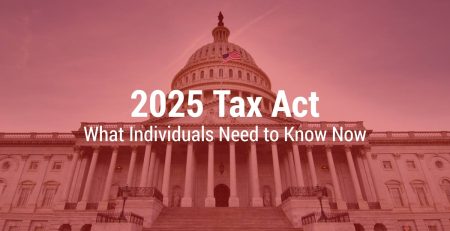Turning Fixed Asset Expensing into Opportunity under the 2025 Tax Act (OBBBA)
The recently enacted 2025 Tax Act, also referred to as the “One Big Beautiful Bill” Act, brings significant enhancements to the tax treatment of fixed asset investments. Whether you are a business owner, CFO, or controller, these changes present powerful opportunities to accelerate deductions, manage taxable income, and invest in your company’s future. Here is what you need to know about the new rules for bonus depreciation, Section 179 expensing, and the new qualified production property expensing.
Fixed Asset Accelerated Bonus Depreciation
- What’s Changing:
- 100% Bonus Depreciation Restored and Made Permanent – this means you can immediately expense the full cost of eligible assets in the year they are placed in service, rather than depreciating them over several years.
- Key Details:
- Property acquired and placed in service after January 19, 2025, qualifies. Property under contract prior to that date follows the old phase‑down schedule (e.g., 40% in early 2025.)
- Includes both new and used tangible personal property (e.g., equipment, machinery, off‑the‑shelf software, qualified improvement property, etc.) with a recovery life of 20 years or less.
- Ideal for businesses seeking large, immediate deductions to bolster cash flow and potentially generate net operating losses (NOLs.)
- Action Items:
- Review purchase timing – If you have signed binding contracts before January 20, 2025, assets may fall under the older, phased‑down bonus schedule. Consider accelerating new purchases to qualify for full 100% expensing.
- Coordinate Section 179 vs. Bonus Depreciation – Leverage Section 179 first—up to income limitations. Then apply bonus depreciation to remaining basis, followed by MACRS on any residual value.
- Consider cost segregation studies for real estate – Particularly valuable for locating shorter-life components in property acquisitions to fully leverage bonus depreciation.
- Consult on state tax conformity – Some states do not conform to bonus depreciation, whereas they may conform to Section 179—making election strategy important.
Section 179 Expensing
- What’s Changing:
- Section 179 Expensing Limit Doubled – this means you can immediately expense the full cost of eligible assets in the year they are placed in service (up to certain thresholds and income limitations), rather than depreciating them over several years.
- Key Details:
- The maximum annual Section 179 deduction jumps to $2.5 million, with a dollar-for-dollar phase‑out starting when total qualifying property placed in service exceeds $4 million. Note: these thresholds will be indexed for inflation beginning in 2026.
- The increased thresholds are effective for property placed in service in taxable years beginning after December 31, 2024.
- Tangible personal property, software, and certain qualified improvements to nonresidential real property qualifies.
- Offers control over which assets are expensed and cannot create or increase an NOL—truly beneficial for income-smoothing strategies. Also, better state conformity in many cases.
- Action Items:
- Coordinate Section 179 vs. Bonus Depreciation – Leverage Section 179 first—up to income limitations. Then apply bonus depreciation to remaining basis, followed by MACRS on any residual value.
- Consult on state tax conformity – Some states do not conform to bonus depreciation, whereas they may conform to Section 179—making election strategy important.
These sweeping enhancements under the 2025 Tax Act (OBBBA) unlock powerful tools for near‑term tax relief, accelerated recovery of capital investments, and strategic planning.
Qualified Production Property Expensing
- What’s Changing:
- New 100% Expensing for Qualified Production Property (QPP) – this means you can immediately expense the full cost of eligible assets in the year they are placed in service, rather than depreciating them over 39 years.
- Key Details:
- A newly created Section 168(n) allows immediate expensing of nonresidential real property used in manufacturing/production activities.
- Construction must begin after January 19, 2025, and before January 1, 2029, with an in‑service deadline after July 4, 2025, and before January 1, 2031 (extended to 2033 if construction begins before 2031). The taxpayer must elect this treatment and use the asset in a qualifying production activity (QPA).
- QPA does not include spaces such as offices, sales and research activities.
- QPP does not include property that is leased to another person.
- Taxpayers must affirmatively elect to treat property as QPP on a timely filed return.
- If the property ceases to be used in a qualified activity within 10 years, the benefit may be recaptured.
- Action Items:
- Evaluate QPP eligibility for manufacturing or production assets – Ensure construction timelines align, use election on return, and properly segregate qualifying portions of property to maximize benefit.
Summary: Immediate Next Steps for Individuals & Businesses
- Review your capital expenditure plans for 2025+ to align purchase and service dates with new expensing benefits.
- Coordinate expensing elections:
- Use Section 179 to the extent allowed by income and business priorities.
- Defer to Bonus Depreciation for remaining basis as needed.
- Plan for MACRS on residual amounts.
- For industrial/production‑focused businesses, explore QPP expensing and align construction timelines accordingly.
- Utilize cost segregation studies on property purchases to maximize shorter-life asset expensing.
- Factor in state-level tax conformity to shape the right mix of expensing tools.
- Plan proactively—proper documentation and timely elections are essential to preserve these benefits and support year-end tax strategy.
- Work with your accounting team to model the tax impact and cash flow benefits of these new provisions.
- Stay alert for IRS guidance and further clarifications as the new rules are implemented.
Hungerford is Here to Help
These sweeping enhancements under the 2025 Tax Act (OBBBA) unlock powerful tools for near‑term tax relief, accelerated recovery of capital investments, and strategic planning. The opportunities span industries—from tech startups to manufacturers and real estate investors.
Navigating these new tax changes can be complex—but the potential savings are substantial. Reach out to Hungerford’s Tax Team today to learn exactly how the 2025 changes will affect your situation and to develop a personalized tax strategy that maximizes your benefits.
Disclaimer: This blog post is for informational purposes only and does not substitute for personalized advice. Please consult your tax professional for guidance tailored to your situation.











